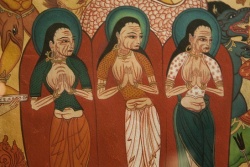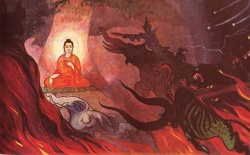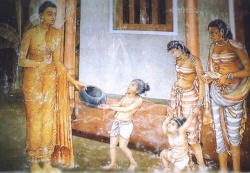Difference between revisions of "Paritta"
| Line 115: | Line 115: | ||
10. [[Khandha-paritta]] ("[[Aggregates Protection]]") AN 4.67 | 10. [[Khandha-paritta]] ("[[Aggregates Protection]]") AN 4.67 | ||
11. [[Metta-anisamsa]] ("[[Lovingkindness Advantages Discourse]]") AN 11.16 | 11. [[Metta-anisamsa]] ("[[Lovingkindness Advantages Discourse]]") AN 11.16 | ||
| − | 12. [[Mitta-anisamsa]] ("[[Friendship Advantages Discourse | + | 12. [[Mitta-anisamsa]] ("[[Friendship Advantages Discourse]]") [[Ja]] 538 |
13. [[Mora-paritta]] ("The [[Peacock's Protection]]") [[Ja]] 159 | 13. [[Mora-paritta]] ("The [[Peacock's Protection]]") [[Ja]] 159 | ||
14. [[Canda-paritta]] ("The [[Moon's Protection]]") SN 2.9 | 14. [[Canda-paritta]] ("The [[Moon's Protection]]") SN 2.9 | ||
Latest revision as of 21:16, 29 February 2016
Paritta (Pali), generally translated as "protection" or "safeguard," refers to the Buddhist practice of reciting certain verses and scriptures in order to ward off evil fortune or dangerous conditions,
as well as to the specific verses and discourses recited as paritta texts. The practice of reciting or listening to the paritta suttas began very early in the history of Buddhism.
Uses
In the Pali literature, these short verses are recommended by the Buddha as providing protection from certain afflictions.
The belief in the effective power to heal, or protect, of the saccakiriya, or asseveration of something quite true is an aspect of the work ascribed to the paritta.
It is also widely believed that all night recitations of paritta by monks bring safety, peace and well-being to a community.
Such recitations will also occur on auspicious occasions, such as the inauguration of a new temple or home or to provide blessings upon those who hear. Conversely, paritta discourses are recited on inauspicious occasions as well,
such as at a funeral or on the death anniversary of a love one. They may also be recited to placate antagonistic spirits.
Discourse types
There are several paritta verses that are identified as such within the Pali Canon.
Reverential
Most paritta involve offering praise to the Buddha or, more broadly, the Triple Gem (Buddha, Dhamma, Sangha).
Of these paritta, one of the best known is the Ratana Sutta (Sn 2.1) where, for instance, it states in part:
Whatever treasure there be either here or in the world beyond, whatever precious jewel there be in the heavenly worlds, there is nought comparable to the Tathagata (the perfect One).
This precious jewel is the Buddha.
By this (asseveration of the) truth may there be happiness.
Aid seeking
A few paritta involve the asking directly for the aid of the Buddha.
Examples of this type of paritta verse can be seen in the Candima Sutta (SN 2.9) and Suriya Sutta (SN 2.10) of the Samyutta Nikaya.
In these two scriptures, the deities Canda and Suriya protect themselves from the attack of the eclipse deity Rahu by reciting short verses praising the Buddha and pleading for his protection:
"O Buddha, the Hero, thou art wholly free from all evil.
My adoration to thee. I have fallen into distress. Be thou my refuge."
In these cases, the Buddha is shown as specifically hearing and responding to the paritta; he enjoins Rahu to release the captive deities rather than have his "head split into seven pieces".
Blessing
Another type of paritta relies on the virtue of the individual who is ascribed as reciting the paritta in the Canon, rather than making reference to the virtues of the Buddha.
This type of paritta can be seen in the Angulimala Sutta, the story of the murderer-turned-monk Angulimala.
On passing a pregnant woman experiencing a difficult labor, Angulimala is moved to provide assistance.
Asking the Buddha how he can help, the Buddha tells him to provide a sort of blessing to the woman by reciting a short verse proclaiming his own virtue:
Sister, since I was born in the noble birth, I do not recall intentionally killing a living being.
Through this truth may there be wellbeing for you, wellbeing for your fetus.
This verse is now used as a blessing for expectant mothers in the Theravada Buddhist tradition.
Forms of expression
The Buddha and the arahants (the Consummate Ones) can concentrate on the paritta suttas without the aid of another.
However, when they are ill, it is easier for them to listen to what others recite, and thus focus their minds on the dhamma that the suttas contain, rather than think of the dhamma by themselves.
There are occasions, as in the case of illness, which weaken the mind (in the case of worldlings),
when hetero-suggestion has been found to be more effective than autosuggestion.
In the Gilana Sutta, even the Buddha Himself had the Seven Factors of Enlightenment recited to him by another monk to recover from a grave illness.
While paritta texts generally are recited aloud, other mediums are known as well.
In Thailand, paritta texts are printed on small pieces of cloth containing images of the Buddha or famous monks.
Similar text- often in the Khom script- is sometimes incorporated into tattoos believed to have protective powers,
known as Sak Yant.
Collections
Paritta discourses are widely used and known, even if not necessarily understood, throughout the Theravada Buddhist world.
Popular collections of paritta verses are among the most widely known Pali texts in many Theravada countries.
An example of such a collection is the Sinhala Pirit Potha ("The Book of Protection"),
also known as Maha Pirit Potha and the Catubhanavarapali ("Text of the Four Recitals").
It has also been referred to as "The Buddhist Bible."
This collection is typically given an important place in the Buddhist home, and is even treated with veneration.
The book contains a collection of twenty-four or twenty-nine discourses (suttas) almost all delivered by the Buddha,
and found scattered in the five original collections (nikayas) in Pali, which form the Sutta Pitaka, the "Canonical Discourses."
Below, these discourses and related canonical sources are identified.
1. Sarana-gama ("Going for Refuge") Khp 1
2. Dasa-sikkhapada ("Ten Training Precepts") Khp 2
3. Samanera-pañha ("Novice Questions") Khp 4
4. Dvattimsakara ("32 Body Parts") Khp 3
5. Paccavekkhana ("Reflections on Monastic Requisites") MN 2 (excerpt), passim
6. Dasa-dhamma Sutta ("[[Ten Dhamma Discourse]") AN 10.48
7. Mahamangala Sutta ("Great Blessings Discourse") Khp 5, Sn 2.4
8. Ratana Sutta ("Three Treasures Discourse") Khp 6, Sn 2.1
9. Karaniya Metta Sutta ("Loving kindness Discourse") Khp 9, Sn 1.8
10. Khandha-paritta ("Aggregates Protection") AN 4.67
11. Metta-anisamsa ("Lovingkindness Advantages Discourse") AN 11.16
12. Mitta-anisamsa ("Friendship Advantages Discourse") Ja 538
13. Mora-paritta ("The Peacock's Protection") Ja 159
14. Canda-paritta ("The Moon's Protection") SN 2.9
15. Suriya-paritta ("The Sun's Protection") SN 2.10
16. Dhajagga-paritta ("Banner Protection") SN 11.3
17. Mahakassapa Thera Bojjhanga ("Elder Maha Kassapa's Factors of Awakening") SN 46.14 (Gilana Sutta I)
18. Mahamoggallana Thera Bojjhanga ("Elder Maha Moggalana's Factors of Awakening") SN 46.15 (Gilana Sutta II)
19. Mahacunda Thera Bojjhanga ("Elder Maha Cunda's Factors of Awakening") SN 46.16 (Gilana Sutta III)
20. Girimananda Sutta ("To Girimananda Discourse") AN 10.60
21. Isigili Sutta ("About Isigili Discourse") MN 116
22. Dhammacakkappavattana Sutta ("Setting in Motion the Dhamma Wheel Discourse") SN 46.11
23. Maha-samaya Sutta ("The Great Assembly Discourse") DN 20
24. Alavaka Sutta ("Concerning Alavaka Discourse") SN 46.11
25. Kasi Bharadvaja Sutta ("Farmer Bharadvaja Discourse") Sn 1.4
26. Parabhava Sutta ("On Ruin Discourse") Sn 1.6
27. Vasala Sutta ("On Outcasts Discourse") Sn 1.7
28. Sacca-vibhanga Sutta ("Analysis of the Truth Discourse") MN 141
29. Atanatiya Sutta ("Atanatiya Discourse") DN 32



